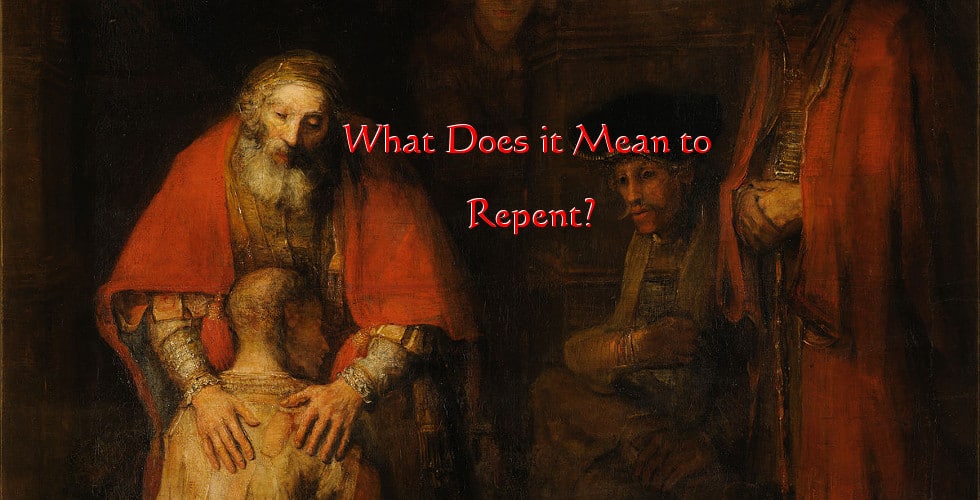This Wednesday, Lent begins. Lent is a 40-day period of fasting, repentance, and prayer that many Christians undertake corporately all over the globe. Lately, I’ve been considering the meaning of “repent” (Hebrew שׁוב; Greek metanoeo) in the terms of how the biblical authors thought about it.
Repent in the Old Testament
In the Old Testament, שׁוב is usually translated “turn back” or “returned” or “restore(d).” In 1958, William L. Holladay, in The Root Subh in the Old Testament, examined each of the 1,064 occurrences of שׁוב, and concluded it indicated movement “in an opposite direction in which one was going with the assumption that one will arrive again at the initial point of departure.”
The idea is to return to the starting point. This usually was in relation to Israel returning to the starting point of the Covenant with God. Occasionally in the Old Testament, it meant God returning to Israel, but only after Israel made the decision first to return to God.
This is most clear in Jeremiah and Deuteronomy, where the prophets admonish Israel to return to God, so the Exile can end.
Thus, repentance is part of reconciliation with God and the end of Exile.
Repent in Second Temple Literature
In Second Temple literature, sometimes repentance means God’s people deciding to return to God and then God granting them reconciliation and an end of Exile. But many other cases, others layers of depth are added to the meaning.
In Wisdom of Solomon, for instance, God grants repentance to Gentiles too, not just to the Jews. So, at least to this author, the Gentiles were also exiled from God.
In some examples of Second Temple literature, divine beings are agents of repentance, such as powerful angels.
In Joseph and Aseneth (a pre-Christian Hellenistic Jewish work) the divine agent of Repentance is linked to Wisdom, the Second Power in Heaven, who grants it forever. The Second Power is sometimes referred to in the Old Testament as the Word of the Lord or the Angel of the Lord and of course, the Wisdom of the Lord. He was in the beginning with God and he is God.
Repent in Greek Literature
In non-biblical Greek literature, “repentance” is further developed, and has four characteristics, according to Guy Nave in The Role and Function of Repentance in Luke-Acts:
- To express an intellectual change of thinking. This is the core meaning of repentance. This changing of the mind leads to…
- An act of emotion. This emotion usually (but not always) leads to a change in behavior. Repentance is more than an intellectual change of opinion. Emotion and action are involved.
- An action to avoid judgement or to receive forgiveness.
- A source of reconciliation between two parties.
These ideas form the backdrop to the New Testament, which was written in Greek and fashioned with a Hebrew and Greek frame, use of the word normally translated as “repent.”
The Gospel writer Luke, who wrote more of the New Testament than anyone else, wrote more extensively about repentance than the other Synoptic authors. For instance, the hope of repentance is central to Luke’s Great Commission (Luke 24:44-49), while absent in Matthew’s (Matthew 28:18-20).
The Prodigal Son
The core ideas related to repentance are found in Luke’s parable of the prodigal son (Luke 15:11-32). Through his own decisions, the son is exiled from the father. After losing everything, the son responds by trying to save himself, albeit disgracefully. In despair, he rationalizes he cannot save himself, and returns to confess his disqualification to be his father’s son. He acts on this, and the father grants complete reconciliation. Then the father addresses the other brother, whose emotions and actions demonstrate he is unwittingly in exile, with the attempt at full reconciliation.
All the themes mentioned above relating to repentance apply for Luke’s parable.
- The son is exiled of his own choice.
- The famine would be seen as coming from a divine agent.
- Based on this divine act, the son uses his reason to change his thinking and abandons his attempt to save himself.
- He forges this change of thinking with emotion.
- His change of thought and emotion subvert the just judgement brought by his own sinful choices.
- The father grants full reconciliation.
- The exile ends.
Meanwhile the father uses reason forged with emotion to subvert the other brother’s exile. These themes continue in Acts.
Paul picks it up in Romans 2, by metaphorically addressing the son who did not flee, but is actually in exile. Paul’s point is everyone is in exile. Therefore, God intervened and through Jesus Christ, God has completed the reconciliation, so people should make reasoned decisions, forged with emotion, leading to action, and thus complete God’s reconciliation by turning towards the Father through faith in the death, burial and resurrection of Jesus Christ.
This is really good news and the message God charges Christ followers to preach to the world. (See 2 Corinthians 5:16-21). So preach the good news… use words if necessary.
The next 40 days, I intend to think more on repentance, considering which of my thinking and actions, my gifts and abilities, could be better submitted to the Father’s rule, as I look towards the Cross and Resurrection, because God’s rule and reign is actually here, it’s overturning the rule of darkness day by day, and I want to be a part of that victory.
—
For more on this topic, see the source material behind the article: MORLAN, DAVID,SCOTT (2010) Conversion in Luke and Paul: Some Exegetical and Theological Explorations, Durham theses, Durham University. Available at Durham E-Theses Online: http://etheses.dur.ac.uk/408/

